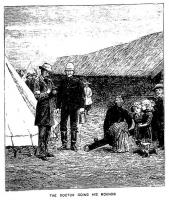
Charles Allen Du Val
His life and works
Siege Of Pretoria
This account of the Siege of Pretoria, and the part played in it by Charles Henry Du Val, while alone in South Africa with his touring show team, is transcribed from a report published in London in The Graphic on Saturday 28 May 1881.
"THE DEFENCE OF PRETORIA
On December 16th, 1880, the Boers hoisted the Republican flag at Heidelberg, and from that time the investment of Pretoria may be said to have been begun, as communications with the outside world were immediately cut, and the besieging Boers formed circles of laagers — built at intervals of a few miles apart — round the town. The British authorities on their side evacuated the town, and ordered all the inhabitants to reside in the military camp and inside a laager. There they settled down as comfortably as they could in huts and tents, bungalows and bullock-waggons, and a system of quartering and rationing was established. Three forts also were erected, two, Forts Commeline and Tullichewan, on commanding positions to the south, and the third, Fort Royal, on the east — all being armed with small Krupp guns. The troops, who were under the command of Lieut.-Colonel Gildea, 2nd Battalion 21st Regiment Royal Scots Fusiliers, behaved admirably throughout the siege, which lasted 102 days, Sir Evelyn Wood's messengers, Lieuts. Cunninghame and Menzies, of the 92nd, and Mr. Ryder, of the 60th, announcing the conclusion of the armistice, arriving on April 28th.

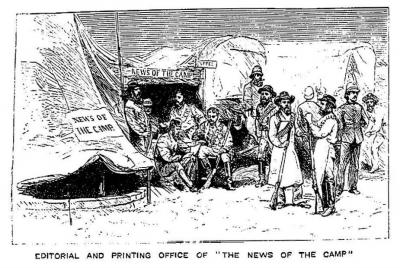
Our engravings are from sketches and photographs furnished by three different gentlemen who underwent the siege. Six of them are sent by Mr. Charles Duval, of the Carbineers attached to the Staff of the Colonel in command, and are from photographs by Mr. H.F. Gros. The centre illustration, "Serving Out Rations," depicts one of the chief incidents of the daily camp routine. Mr. Duval writes; "The camp was divided into several wards, and from the headquarters of each bread and meat was issued daily, and groceries twice a week. In the illustration Mr. Justice Kotze is presiding over the proceedings, and it is surprising how little grumbling there has been on the part of the public." " The Editorial and Printing Offices of The News of the Camp" represents the publishing tent of a small tri-weekly journal edited by Mr. Charles Duval and Mr. E. W. Deecker, one of the former proprietors of the Transvaal Argus. The News of The Camp (1) contained a series of articles, humorous anecdotes of camp-life, reports of the engagements round Pretoria, &c., and was edited, as may be seen, under considerable disadvantages, editors and compositors alike taking their turn in the military duties, and working with their gun and cartridge belt beside them so as to be ready at any moment to turn out if needed.
The illustration of the "Intelligence Department" represents the signal station in Flagstaff Square, where communications were despatched and received to and from the forts and other prominent positions in the vicinity by means of the heliograph and flags. The duties of the doctors during the siege were exceedingly important and onerous, for as some five or six thousand persons were packed together in a very small space, the most careful sanitary precautions were necessary to prevent the outbreak of malignant disease. To the admirable measures adopted, as well as to the general salubrity of the climate, must be attributed the excellent health which was enjoyed by the troops and civil population —the deaths during the siege scarcely exceeding a score, One illustration depicts Dr. Dyer, the district surgeon, going his rounds. He was preceded by an orderly, who rang a cow bell to warn the patients of his approach.
In the illustration of the Garrison Commandant and Staff, a native has just been brought in by the principal scout of Mr. Melville's Intelligence Department, and is about to be questioned. He sits Zulu fashion while Mr. Melville translates his intelligence,- not always very trustworthy. Lieut.-Colonel Gildea sits in the centre, with his indefatigable and hard-working Adjutant, Lieutenant Chichester, on his left, while Mr. Duval, of the Carbineers, is leaning against the sentry-box. The sergeant-major and the "boss of the scouts" form the other side of the picture. The erection at the back is the garrison office.
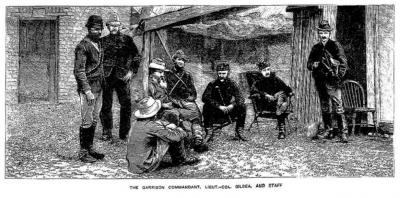
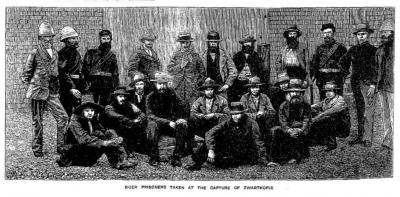
The Boer prisoners taken at the capture of Zwartkopje did not appear to be especially prepossessing, but they gave a great deal of trouble before surrendering, and managed to disable several of our men. The man in the wide black hat, on the left, the only one not taken in the above-mentioned affair, was captured during a night patrol by Lieut.-Colonel Gildea. A curious aspect he presented with his "Dopper hat," turned up with green, and a pair of enormous black goggles. These prisoners were liberated unconditionally on February 13th, after the engagement at Red House Kraal, in which our troops failed to destroy the enemy's laager.
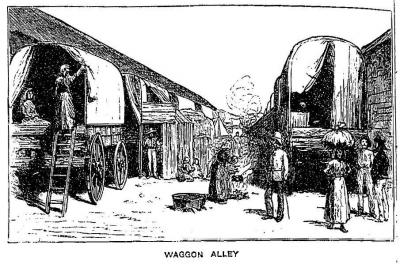
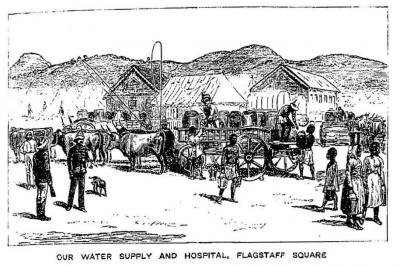
Two of our illustrations are from sketches by Mr. F.E. Mulcahy, of the Ordnance Store Department. One of them represents the Waggon Laager, which was formed in what was supposed to be the best position. The Transvaal people take very kindly to waggon life and its exigencies and although of course the inevitable grumblers were not absent, the great majority seemed satisfied with their accommodation. The next sketch shows "Our Water Supply and the Hospital." One of the most amusing scenes in camp was the arrival of the waggons which conveyed the barrels containing the water from the channel which supplied Pretoria. "Although not always pellucid," writes the artist, "still, for South Africa, our water was good, and these water waggons conferred a great boon on the camp, as the wells were not supposed to give water of unquestionable quality." The hospital, situated in Flagstaff Square, contained some ninety patients at the time of the sketch, many of whom were from the action at Bronkhorst Spruit, "sadly torn," writes the artist, "by the tremendous hail of bullets poured upon them with such unerring accuracy. There were also one or two Boers, wounded in the affairs round Pretoria, who treated their misfortunes with a most philosophic indifference, principally wondering that the Englishmen should take so much care of mangled enemies.”
The illustration of the Officers' Quarters, Fort Commeline, is from a sketch by Lieutenant C.E. Commeline, R.E., and represents the interior of one of the most important look-out stations and redoubts, positions which might have been occupied by the enemy to the great discomfort of the camp. The fort is a rough stone blockhouse, holding a garrison of from twenty-five to thirty men, and a Krupp gun. As a look-out station it proved invaluable; a very wide expanse of country and several of the principal centres of the besieging force being visible from it.
A BOER VEDETTE
One of the chief features of the Boer force was the number of scouts who, well-mounted and armed with capital rifles, kept head-quarters well informed of the British movements, and maintained communication between the various Boer detachments. The Boers are as good horsemen as they are sharpshooters, and are admirably fitted for every species of guerilla warfare."
(1) The News of the Camp was edited and printed during the siege from December 1880 until April 1881.
For a collection of the press reports on Charles Henry Du Val see Charles Henry Du Val Press Cuttings.



